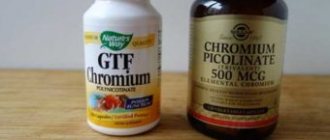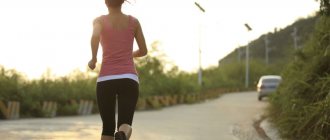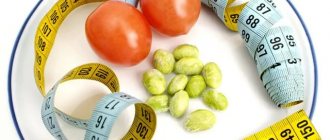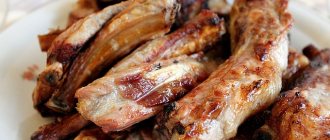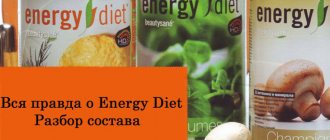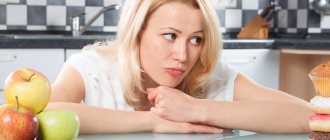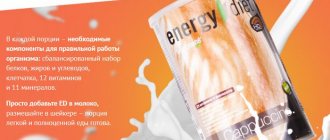General rules
Low-carbohydrate nutrition is represented by a wide range of low-carbohydrate diets, ranging from classic diets with a slight restriction of the carbohydrate component to the Keto diet , in which the traditional biochemical processes of providing the body with energy are excluded and an alternative mechanism for obtaining energy is launched.
One of the varieties of this type of diet is a high-fat, low-carbohydrate diet, the so-called low carb/high fat (LCHF diet), which translates as “low carbohydrates/high fat.” As you know, with normal nutrition, the main source of energy is carbohydrates ( glucose ), which generate energy through the process of metabolism ( glycolysis ). At the same time, nature also provides other metabolic mechanisms for energy production:
- gluconeogenesis - obtaining energy through the utilization of proteins;
- ketogenesis is the production of energy from adipose tissue, which during metabolism breaks down into ketone bodies.
With sufficient consumption of carbohydrates, the process of glycolysis occurs. At the same time, the level of insulin , which triggers the process of glycolysis. The resulting glucose is partially used for:
- energy supply to the body;
- deposited in the liver/muscles in the form of glycogen ;
- turns into fat and is deposited in the body (with excess glucose intake).
insulin is produced , which blocks a metabolic pathway for energy production such as ketogenesis ( lipolysis ). The diet of the vast majority of people in the modern world contains large amounts of starches and sugars. Essentially, the metabolism on this diet functions by producing increased levels of insulin and occurs outside of the process of ketosis , which is regarded as a potentially dangerous condition, accompanied by increased stress on the liver and contributing to the loss of muscle tissue.
However, this is not entirely true; the main danger is the process of “acidification” of the blood, which occurs in a number of diseases/conditions, in particular diabetes , fasting - the formation in large quantities of ketone bodies consisting of acetoacetic / hydroxybutyric acids / acetone , which are transported from the liver to peripheral tissues. But due to their high concentration in the incoming blood, the muscles/organs cannot cope with their oxidation, which leads to the development of ketonemia . Unlike “malignant”, benign dietary ketosis occurs against the background of normal insulin levels without symptoms of intoxication of the body.
Thus, the main goal of a high-fat diet is to achieve a state of dietary ketosis/lipolysis, in which the body begins to use its own stored fats to meet energy needs. In fact, the phenomenon of ketosis should be considered as a tool for transferring the body to the process of burning fats, which first break down into glycerol and free fatty acids, which continue, accordingly, to break down into so-called “ketone bodies” with the formation of a new fatty acid, which is used as fuel. Ketones are excreted from the body through the respiratory tract and urine.
The downside of a low-carb diet is the potentially high risk of muscle loss due to protein breakdown and cortisol- . This process is prevented by growth hormone, which counteracts cortisol, activating the process of penetration of amino acids into the muscles. You can also paralyze the effects of cortisol by eating more protein. In this case, the protein supplied with food will be used to obtain energy, and muscle protein will not be involved in the process.
According to scientific research, for this you need to get 2.5-3.0 protein/1 kg of body weight. But a more correct approach to the amount of protein consumed is the level of physical activity. That is, if you need to speed up fat burning and at the same time increase muscle mass, the protein content in the diet should be on average 3 g/kg of weight, and if there is no goal to build muscle, with standard physical activity, the protein component in the diet should be within the physiological range norms.
Thus, the diet should be high in fat, physiologically sufficient in protein and very low in carbohydrates (20-50 g/day). It is also important to constantly monitor the total carbohydrate content, especially the so-called “hidden” carbohydrates, and maintain a high level of fat in the diet so as not to leave the ketosis process. To do this, the level of carbohydrate content should not exceed an average of 50 g/day. Many people do not understand the difference between ketogenic diets and a standard low-carbohydrate diet with carbohydrate restriction in the diet at the level of 150-200 g/day, in which the process of ketosis does not start.
That is, the compositions of the main dietary macronutrients in traditional low-carbohydrate diets do not meet the requirements of ketogenic diets. Ideally, when trying to lose weight, it is advisable not to leave ketogenesis before reaching the target level, since this state is quite comfortable for losing weight and, moreover, there is no need to re-activate this mechanism. It should be remembered that stopping ketogenesis is quite simple, even without knowing it. Therefore, remember that even a small intake of an unexpected additional amount of carbohydrates (a bun, a bagel) will take your body out of ketosis and the process will have to be restarted. Signs of the body’s transition to ketogenesis are:
- decreased appetite;
- the appearance of ketones in the urine (test with special strips);
- the appearance of the smell of acetone from the mouth, sweat, urine;
- improved mood, increased energy, increased strength/vigor.
Classic low-carbohydrate diets (low-fat/low-calorie), unlike keto diets, are accompanied throughout their entire duration by lethargy, weakness, a feeling of constant hunger, and decreased performance. At the same time, average fat burning, low insulin , and loss of muscle mass are observed.
Many may wonder if there are differences between the keto diet and the LCHF diet, and if so, what are they? There is no fundamental difference. Each of them is based on the process of ketosis, but the LCHF diet is a milder nutritional option. Now let's look at the LCHF diet in more detail.
The approximate standard for the content of basic food nutrients in the diet is 20% proteins, 70-75% fats and 5-10% carbohydrates. With a strict version of the LCHF diet, carbohydrate intake is limited to 10-20 g/day, with a more liberal version - 50 g. At the same time, the ratio of proteins and fats in the first days of the diet should be 1:1, and only after the body passes through the “metabolic threshold” the level of fat in the diet increases to 70-75%.
The question of the total calorie content of the daily diet is also of some interest, since most people assume that if there are no strict restrictions on protein and fatty foods, then they can be consumed in any quantity. This is not entirely correct, since the overall energy value of the diet is of primary importance, but it all depends on the task at hand.
If your goal is simply to lose weight, then it is recommended to reduce the caloric content of your daily diet by 500-600 kcal from the norm. If your goal is to gain muscle mass while burning fat, then the calorie content of your diet increases by 500-600 Kcal. These indicators can vary significantly depending on the level of metabolism/energy consumption of the body.
The positive aspects of the LCHF diet when trying to lose weight are:
- Body weight is lost due to adipose tissue.
- Weight loss is accompanied by a general improvement of the body, due to the stimulation of CMA autophagy - a cellular process of removing organelles, proteins and foreign bodies from the aqueous component of the cell ( cytosol ) and transporting them to lysosomes for disposal. In addition, against the background of low-carbohydrate ketogenic diets, metabolic effects such as a decrease in blood glucose levels, excretion of ketone bodies in the urine, normalization of insulin levels/lipid profile, and normalization of blood pressure .
- Weight loss occurs without the feeling of hunger and in a state of psychological comfort.
When building an LCHF diet, carbohydrates are primarily limited. Sugars and their artificial substitutes, sweets, sweet juices, cakes, chocolate, buns, cakes, pastries, honey, jam, ice cream, jam, honey, sauces with added sugar, sweet juices, curds, jelly/compotes, sweet yoghurts are excluded.
The list of prohibited products includes products containing starch (pasta, bread - black/white, cereals, chips, rice, muesli and all whole grain products - bread, sunflower seeds), legumes.
Sweet fruits, dried fruits and all root vegetables (beets, carrots, celery root, potatoes) containing a lot of starch and sugars, alcoholic beverages, especially beer, kvass, sweet/semi-sweet wines are excluded.
Above-ground vegetables (eggplant, cucumbers, tomatoes, onions, all types of cabbage, zucchini/zucchini, leafy greens) may be present in the diet as a carbohydrate component. Unsweetened fruits/berries and nuts (cashews, walnuts, flaxseed, sesame) are allowed in minimal quantities.
It is recommended to exclude trans fats from the fat part of the diet (spreads with trans fats, margarine); if lactose is intolerant, use whole/skimmed milk. Protein products and fatty foods are allowed - concentrated fatty broths, fatty meats/sea and river fish (cod, salmon, salmon, herring), meat products (bacon, boiled pork, balyk, sausages), fatty poultry meat (goose, duck), butter/vegetable oil, high-fat dairy/fermented milk products, sauces/homemade mayonnaise, fatty hard/soft cheeses, eggs, mushrooms, seafood (shrimp, squid), bran.
It is recommended to use animal proteins as the protein component. It is extremely important to control the amount of free fluid consumed, the volume of which should be at least 3.0 l/day at the rate of 40 ml/1 kg of weight. The salt content and the limitation of various types of pickles are also slightly limited. Diet: at least 5 times a day with an interval between meals of no more than 3-4 hours. The last meal is 3-3.5 hours before bedtime.
Permitted and prohibited products
Prohibited:
- sugar, honey and artificial sweeteners (the harmlessness of stevia is greatly exaggerated, sweeteners increase appetite, support cravings for sweets, and sugar is not at all what is needed for a healthy body);
- sweet carbonated drinks;
- yeast bread, pastries;
- cereals, porridges, flakes, breakfast cereals;
- skim milk, kefir, yoghurts;
- sweet curds;
- margarine, spreads with trans fats.
Allowed:
- butter, coconut, vegetable oil;
- high-fat dairy and fermented milk products (sour cream, cream, cottage cheese);
- fatty meats, poultry (with skin). It is advisable to buy meat from farmers, and not from store shelves. Store-bought meat contains a lot of hormones and antibiotics;
- salo;
- broths;
- boiled pork, bacon, jamon, balyk;
- fish (mackerel, salmon, herring, salmon) and seafood (clams, shrimp, squid);
- eggs;
- fatty hard and soft cheeses;
- avocado;
- sauces, homemade mayonnaise;
- mushrooms;
- vegetables;
- nuts, nut butters;
- leaf salads (lettuce, spinach, lollo rossa, iceberg, arugula and others);
- sour berries;
- any sources of additional fiber (bran, psyllium (isfagula));
- shirataki noodles;
- olives, olives.
In limited quantities you can:
- dark chocolate with cocoa content from 70%;
- starchy vegetables;
- fruits;
- Tea coffee;
- low carb pasta;
- pickles, pickled vegetables;
- baked goods made from carbohydrate-free coconut and almond flour;
- pumpkin
Authorized Products
The diet of the LCHF diet is formed mainly due to:
- fatty meat/fish broths and first courses based on them (solyanka, borscht);
- red meat of fatty varieties in any culinary processing, meat products (ham, bacon, sausages, smoked meats), poultry meat (chicken, duck, goose);
- fatty varieties of river/sea fish (salmon, tuna, herring), seafood;
- chicken eggs, fatty sauces;
- high-fat dairy products (butter, cream, sour cream, cottage cheese, hard cheese);
- vegetable oils (olive, corn, sunflower, flaxseed);
- above-ground vegetables (celery stalks, eggplants, cucumbers, tomatoes, onions, all types of cabbage, zucchini/zucchini, green beans, leafy greens).
- nuts/seeds (walnuts, cashews, peanuts, flax seeds, olives, sesame).
Table of permitted products
| Proteins, g | Fats, g | Carbohydrates, g | Calories, kcal | |
Vegetables and greens | ||||
| green peas | 5,0 | 0,2 | 13,8 | 73 |
| zucchini | 0,6 | 0,3 | 4,6 | 24 |
| Brussels sprouts | 4,8 | 0,0 | 8,0 | 43 |
| cabbage | 1,2 | 0,2 | 2,0 | 16 |
| cauliflower | 2,5 | 0,3 | 5,4 | 30 |
| cucumbers | 0,8 | 0,1 | 2,8 | 15 |
| olives | 0,8 | 10,7 | 6,3 | 115 |
| iceberg lettuce | 0,9 | 0,1 | 1,8 | 14 |
| celery | 0,9 | 0,1 | 2,1 | 12 |
| green beans | 2,8 | 0,4 | 8,4 | 47 |
Mushrooms | ||||
| mushrooms | 3,5 | 2,0 | 2,5 | 30 |
Nuts and dried fruits | ||||
| nuts | 15,0 | 40,0 | 20,0 | 500 |
| peanut | 26,3 | 45,2 | 9,9 | 551 |
| flax seeds | 18,3 | 42,2 | 28,9 | 534 |
Cereals and porridges | ||||
| white rice | 6,7 | 0,7 | 78,9 | 344 |
Raw materials and seasonings | ||||
| mayonnaise | 2,4 | 67,0 | 3,9 | 627 |
Dairy | ||||
| milk 3.2% | 2,9 | 3,2 | 4,7 | 59 |
| condensed milk | 7,2 | 8,5 | 56,0 | 320 |
| kefir 3.2% | 2,8 | 3,2 | 4,1 | 56 |
| cream 20% (medium fat content) | 2,8 | 20,0 | 3,7 | 205 |
| sour cream 25% (classic) | 2,6 | 25,0 | 2,5 | 248 |
| Ryazhenka 6% | 5,0 | 6,0 | 4,1 | 84 |
Cheeses and cottage cheese | ||||
| cheese | 24,1 | 29,5 | 0,3 | 363 |
Meat products | ||||
| pork | 16,0 | 21,6 | 0,0 | 259 |
| salo | 2,4 | 89,0 | 0,0 | 797 |
| boiled beef | 25,8 | 16,8 | 0,0 | 254 |
| boiled veal | 30,7 | 0,9 | 0,0 | 131 |
| rabbit | 21,0 | 8,0 | 0,0 | 156 |
| bacon | 23,0 | 45,0 | 0,0 | 500 |
| ham | 22,6 | 20,9 | 0,0 | 279 |
| raw smoked pork loin | 10,5 | 47,2 | — | 467 |
| meat pate | 16,4 | 23,3 | 0,4 | 277 |
| pork cutlets | 13,6 | 45,7 | 8,8 | 466 |
Sausages | ||||
| smoked sausage | 28,2 | 27,5 | 0,0 | 360 |
| dry-cured sausage | 24,1 | 38,3 | 1,0 | 455 |
| smoked sausage | 9,9 | 63,2 | 0,3 | 608 |
| sausages | 10,1 | 31,6 | 1,9 | 332 |
| sausages | 12,3 | 25,3 | 0,0 | 277 |
Bird | ||||
| boiled chicken | 25,2 | 7,4 | 0,0 | 170 |
| turkey | 19,2 | 0,7 | 0,0 | 84 |
| duck | 16,5 | 61,2 | 0,0 | 346 |
| goose | 16,1 | 33,3 | 0,0 | 364 |
Eggs | ||||
| soft-boiled chicken eggs | 12,8 | 11,6 | 0,8 | 159 |
Fish and seafood | ||||
| pink salmon | 20,5 | 6,5 | 0,0 | 142 |
| Red caviar | 32,0 | 15,0 | 0,0 | 263 |
| cod roe | 24,0 | 0,2 | 0,0 | 115 |
| salmon | 19,8 | 6,3 | 0,0 | 142 |
| seafood | 15,5 | 1,0 | 0,1 | 85 |
| sturgeon | 16,4 | 10,9 | 0,0 | 163 |
| canned fish | 17,5 | 2,0 | 0,0 | 88 |
| herring | 16,3 | 10,7 | — | 161 |
| cod (liver in oil) | 4,2 | 65,7 | 1,2 | 613 |
| tuna | 23,0 | 1,0 | — | 101 |
| acne | 14,5 | 30,5 | — | 332 |
| sprats | 17,4 | 32,4 | 0,4 | 363 |
Oils and fats | ||||
| vegetable oil | 0,0 | 99,0 | 0,0 | 899 |
| butter | 0,5 | 82,5 | 0,8 | 748 |
| linseed oil | 0,0 | 99,8 | 0,0 | 898 |
| animal fat | 0,0 | 99,7 | 0,0 | 897 |
| cooking fat | 0,0 | 99,7 | 0,0 | 897 |
Non-alcoholic drinks | ||||
| mineral water | 0,0 | 0,0 | 0,0 | — |
| green tea | 0,0 | 0,0 | 0,0 | — |
| black tea | 20,0 | 5,1 | 6,9 | 152 |
| * data is per 100 g of product | ||||
Diet on the LCHF diet
Diets is a column about what and why people around us eat.
My ninth hero is film producer Sam Klebanov. The Swedish low-carb, high-fat diet LCHF (low carb high fat) helped him lose 15 kg and free himself from cravings for baked goods and desserts. Carbohydrates are limited to 10–50 g per day, proteins - no more than 100 g, and the body receives all other calories from fats. Having tested the method on himself, Sam decided to popularize it in Russia - he founded the LCHF.RU project and published the Swedish bestseller “Revolution in Food” in Russian. LCHF: diet without hunger." According to him, the decision to switch to LCHF food was one of the best in his life, like the decision to shave his head bald. About the pros and cons of LCHF
I have been following the LCHF diet since October 2013. During this time, I lost 14-15 kg (my maximum weight in January 2013 was 107.5 kg) and again returned to the weight that I had not had for 15 years. In addition, the strange cough that had been bothering me for many years disappeared. reasons unknown to doctors. I think I get less colds in the winter. I haven’t taken any tests yet because I don’t feel at risk. Perhaps I’ll rent it out someday out of “scientific interest.”
Eating according to the LCHF principles is easy and comfortable for me. Of course, there was a transition period when I looked sadly at baking and desserts, but it passed pretty quickly and I stopped paying attention to the food I didn’t eat. For me, it turned into an analogue of wax fruits - beautiful to look at, but not edible.
The main advantage of LCHF, in addition to the positive effect on your figure and health, is long-term saturation. The hunger pangs, when you really want to eat something urgently, have disappeared. I don't feel addicted to food and eat much less often than before. Another good thing about LCHF food is that you don’t feel sleepy afterwards, which is especially good for work. The condition when at 3-4 o'clock in the afternoon you begin to fall asleep at work has disappeared.
I don’t see any particular disadvantages, except that from time to time I find myself in a situation where I have nothing to eat, because all the food in the access area is sandwiches and pastries. For example, at the airport during a short layover, when there is no time to go to a normal restaurant, and all fast food is inedible for me. In general, eating quickly is a problem, because most fast food is poorly adapted to LCHF, although suitable options are already beginning to appear in Sweden.
About fruits
I eat fruit quite rarely - let's say, this week I only eat a couple of small pieces of watermelon. The reason is simple - they have too much sugar. During the season I eat a little more of them. For example, I eat 1-2 apples from my apple tree - they are much tastier than store-bought ones and not so sweet. In the summer I eat strawberries, but also less than before. When watermelon is in season - a couple of slices (not half a watermelon, as before LCHF). Sometimes I can eat a few slices of orange or tangerine.
My craving for sweets has disappeared, although I used to really love all kinds of desserts. I sometimes make LCHF desserts and I like them, but they don’t cause the same cravings that sugar did. Those. I can easily do without them for a long time. Among my favorites are chocolate muffins and brownies (very tasty and very easy to prepare), tiramisu, panna cotta, strawberry pie with coconut flour.
About meat
To be honest, I have no secrets about where and how to choose meat. And there’s no time to go to special places to get it either. I usually go to the nearest store - both in Sweden and in Moscow. But it seems to me that in Sweden the local meat is of pretty good quality. At least, that’s what the Swedes themselves think and buy it.
About sweeteners
I use them quite rarely - only for sweet pastries and desserts. I usually cook something sweet if guests come or I need to work on a new recipe for the site, i.e. not every day. In Sweden I use (Sukrin) - it is either pure erythritol, or the same, but with a very small addition of stevia. I settled on it because erythritol tastes closest to sugar and, unlike stevia, does not have any strange aftertaste/aftertaste. This natural substance is found in some fruits (for example, pears) and mushrooms, is well studied, has a zero glycemic index and practically does not provoke insulin production. As far as I know, erythritol has no side effects when used in moderation.
About water
I don’t count liters and glasses - the figure 2 liters, in my opinion, is clearly taken from the ceiling - but I drink quite a lot. In Sweden, good drinking water comes from the tap. I also like sparkling water and buy local brands - Ramlösa, Loka, Premier. Plus there is also good German water Saskia. In Russia I usually buy Arkhyz and really love Borjomi.
About physical activity
I used to have a gym membership in both Moscow and Gothenburg, but now I spend much less time in Russia and it makes no sense to buy two memberships. In Sweden I exercise 4-5 times a week. This is a gym a couple of times a week, beach volleyball - 2 times a week for 2 hours. Moreover, all year round, since Gothenburg has the largest beach volleyball hall in the world, where you can play in winter. From March to October I actively engage in cycling, especially in the summer, so in the summer I go to the gym much less often. I also do wakeboarding, but also only in the summer, of course. When I’m in Moscow, I don’t go to the gym, but I play beach volleyball from time to time. When I travel (as, for example, now in Buenos Aires), I try to periodically go to the gym - usually hotels have this opportunity.
About the book “Revolution in food. LCHF: diet without hunger"
I hardly read any books about diets - in my opinion, most of them are simply unreadable. But the book “Revolution in Food. LCHF: Diet Without Hunger" by Andreas Enfeldt is not about dieting and is surprisingly easy to read. It is about all of us, about how we are structured, what our body does with the food it absorbs, what food causes us damage, and what food corrects this damage. It tells a very fascinating story of the struggle between opposing concepts of healthy eating, a struggle in which it was not the truth that won, but administrative resources and marketing talent. There is a lot of practical advice and answers to questions that concern many. I like that Enfeldt doesn’t push his opinion, doesn’t promote a diet named after himself, and doesn’t play guru. Instead, he becomes our guide to the world of modern science - what he writes about is based on serious scientific research. At the end there is a section of links to works published in scientific journals, which is very important for such books. This book changed my life, nutrition and health.
Day 1
9.45 Breakfast
Three scrambled eggs, tomato, cucumber, mozzarella, homemade cheese, brisket (I would also like bacon, but sanctions prevented it). Coffee with cream (35%) plus cottage cheese (12%) with cream and sour cream (30%).
16.00 Quick snack without interrupting work Cheese: homemade and maasdam, walnuts. Coffee with cream.
20.30 Dinner at the Uryuk restaurant, combined with a friendly business meeting. Eggplant rolls, Uzbek pickles, Tashkent tomatoes. Lamb shish kebab with fat tail, baked eggplant with sesame paste. Dry red wine.
0.55
A cup of Ceylon tea with cream.
Day 2
Breakfast 10.30 Scrambled eggs of 3 eggs with tomatoes, brisket, suluguni cheese, greens, cucumber, celery. Coffee with cream (35%), cottage cheese with cream and sour cream.
Then I spent the whole day in the office. There is a canteen there, but it’s not very good, so I rarely go there. And there was no time to go anywhere else. But when you follow LCHF, you feel full for a long time, so you can easily skip lunch.
Dinner 22.20 Chicken liver stewed in cream, fried zucchini, salad of tomatoes, onions, celery, walnuts with sour cream. Marinated tomatoes from mother-in-law. Tea with cream.
Day 3
Breakfast 11.00 Curd pancakes with psyllium, sour cream 30%, coffee with cream.
Lunch 10/18 Chicken breast, cauliflower (both fried in butter), fresh vegetable salad with sour cream (for a proper LCHF lunch, there was not enough fatty chicken sauce, for example, béarnaise, but there was no time to prepare it ).
Late dinner - midnight I was visiting a friend, teaching her the intricacies of low-carb baking, so the dinner was appropriate: a piece of low-carb (2.5% carbohydrates) bread with butter, a couple of cheese muffins with sun-dried tomatoes (made from almond and coconut flour), tea with cream.
Day 4
Breakfast 12.00 Omelette with cream and cheese from 3 eggs, boiled pork, suluguni cheese, tomatoes, greens. Coffee with cream.
Lunch 16.40 Roast pork, stewed in cream with herbs, zucchini pancakes (one grated zucchini, 2 eggs, 1 tbsp. psyllium, 2 tbsp. coconut flour, fry in coconut oil), sour cream.
At 19.20 I flew to Buenos Aires via Madrid. Airplane food is a problem for me, there is too much that I don't eat. If you fly close, then it’s not scary, you can fly without food, but if the flight is so long, then you need to take it with you.
20.00 - food was brought, I picked out a piece of salted salmon and white fish from it. I left the rest.
23.20 (local time) - transfer in Madrid, dinner. I eat what I took with me, because... there is no time to go to a restaurant, and all the “fast food” that you can buy at the airport is sandwiches and pastries. Baked pork, smoked cheese, suluguni, tomatoes. Tea with milk.
Day 5
7.20am (Eastern Argentine Time) - Breakfast on the plane. Because The airline only offers a baguette and a bun, then I eat my own: boiled pork, cheeses, tomatoes.
15.40 lunch “Mini-steak” (i.e. a normal European size steak), pumpkin puree, pickled eggplant. Sparkling water. Coffee with milk.
21.40 — dinner Grilled blood sausage, vegetable salad. Steak “Bife de chorizo” medium rare, normal Argentine size (i.e. huge, half a plate, 400 grams). Red wine.
Day 6
9.00 Breakfast at the hotel Scrambled eggs, bacon, ham, jamon, cheese, cream cheese, tomatoes, nuts. Coffee with milk.
16.30 lunch: grilled sausages - chorizo and bloody sausages, broccoli, greens. Sparkling water, coffee.
Dinner 21.30, buffet at La Bistecca restaurant. A set of cold appetizers, mozzarella, tomatoes, pate, greens. Different types of grilled meat: pork, beef, chicken, lamb ribs, homemade sausage, grilled vegetables.
Day 7
Breakfast 09.20 Scrambled eggs, bacon, grilled sausages, cheese, salami, jamon, tomatoes. Two slices of watermelon. Coffee.
Lunch 15.00 Salad with seafood (you can ignore the bread, it’s an element of restaurant decor, I didn’t eat it). Sparkling water.
Light dinner 20.40 Cocktail at the film market: white wine, cheeses, jamon.
Fully or partially limited products
The LCHF diet includes dietary restrictions:
- sugar, jam, jams, honey, sweets, chocolate, ice cream, sorbitol/fructose products;
- white bread, cereals, pasta, crackers, pastries, cookies, cakes, waffles;
- starchy vegetables (potatoes, beets, carrots, eggplants, celery root);
- sweet fermented milk products, various dried fruits, sweet carbonated drinks, milk, powdered drinks, bran;
- sweet fruits and juices from them (grapes, banana, melon, watermelon), beer, kvass, sweet/semi-sweet/fortified wines, caffeine-containing drinks (cola, Pepsi), jelly, compotes.
Table of prohibited products
| Proteins, g | Fats, g | Carbohydrates, g | Calories, kcal | |
Vegetables and greens | ||||
| potato | 2,0 | 0,4 | 18,1 | 80 |
| carrot | 1,3 | 0,1 | 6,9 | 32 |
| radish | 1,2 | 0,1 | 3,4 | 19 |
| turnip | 1,5 | 0,1 | 6,2 | 30 |
| beet | 1,5 | 0,1 | 8,8 | 40 |
Berries | ||||
| grape | 0,6 | 0,2 | 16,8 | 65 |
Snacks | ||||
| potato chips | 5,5 | 30,0 | 53,0 | 520 |
Cereals and porridges | ||||
| buckwheat porridge with milk | 4,2 | 2,3 | 21,6 | 118 |
| semolina | 10,3 | 1,0 | 73,3 | 328 |
| pearl barley | 9,3 | 1,1 | 73,7 | 320 |
| Wheat groats | 11,5 | 1,3 | 62,0 | 316 |
| millet cereal | 11,5 | 3,3 | 69,3 | 348 |
| white rice | 6,7 | 0,7 | 78,9 | 344 |
Flour and pasta | ||||
| pasta | 10,4 | 1,1 | 69,7 | 337 |
| spaghetti | 10,4 | 1,1 | 71,5 | 344 |
| pancakes | 6,1 | 12,3 | 26,0 | 233 |
| vareniki | 7,6 | 2,3 | 18,7 | 155 |
| dumplings | 11,9 | 12,4 | 29,0 | 275 |
Bakery products | ||||
| vysivkovy bread | 9,0 | 2,2 | 36,0 | 217 |
| Rye bread | 6,6 | 1,2 | 34,2 | 165 |
Confectionery | ||||
| jam | 0,3 | 0,2 | 63,0 | 263 |
| jam | 0,3 | 0,1 | 56,0 | 238 |
| candies | 4,3 | 19,8 | 67,5 | 453 |
| cookie | 7,5 | 11,8 | 74,9 | 417 |
| crackers with raisins | 8,4 | 4,9 | 78,5 | 395 |
| dough | 7,9 | 1,4 | 50,6 | 234 |
Ice cream | ||||
| ice cream | 3,7 | 6,9 | 22,1 | 189 |
Cakes | ||||
| cake | 4,4 | 23,4 | 45,2 | 407 |
Chocolate | ||||
| chocolate | 5,4 | 35,3 | 56,5 | 544 |
Raw materials and seasonings | ||||
| honey | 0,8 | 0,0 | 81,5 | 329 |
Dairy | ||||
| fruit yogurt 3.2% | 5,0 | 3,2 | 8,5 | 85 |
Alcoholic drinks | ||||
| liquor | 0,3 | 1,1 | 17,2 | 242 |
| beer | 0,3 | 0,0 | 4,6 | 42 |
| cider | 0,2 | 0,3 | 28,9 | 117 |
Non-alcoholic drinks | ||||
| cola | 0,0 | 0,0 | 10,4 | 42 |
| coffee with milk and sugar | 0,7 | 1,0 | 11,2 | 58 |
| Pepsi | 0,0 | 0,0 | 8,7 | 38 |
| energy drink | 0,0 | 0,0 | 11,3 | 45 |
Juices and compotes | ||||
| compote | 0,5 | 0,0 | 19,5 | 81 |
| grape juice | 0,3 | 0,0 | 14,0 | 54 |
| pear juice | 0,4 | 0,3 | 11,0 | 46 |
| jelly | 0,2 | 0,0 | 16,7 | 68 |
| raspberry juice | 0,8 | 0,0 | 24,7 | 100 |
| * data is per 100 g of product | ||||
Does it turn out that LCHF nutrition is unbalanced? Is this an extreme diet?
It depends on what we mean by the phrase “extreme diet.” Lions eat only meat, polar bears only eat fat, and pandas chew bamboo. No mammal has a “balanced” diet. Balance is what has worked for every species for millions of years.
There are essential amino acids and essential fatty acids, but there are no carbohydrates that are essential for humans. That's why we're cutting them down. However, they are still present even in the strictest keto diet. Lowcarbers tend to eat much more greens than lowcarbers.
On the keto diet, they eat vegetables that grow above the surface of the earth. On the carnivore diet (this is also a type of keto), all vegetation is temporarily excluded. And this is also possible.
From the moment the persecution of fats began, and, moreover, the pyramid of proper nutrition, which is based on a lot of carbohydrates, was approved, the health of mankind has only worsened.
Do animal fats pose a health risk?
No, if you eat them with vegetables and herbs, and not with a bun, potatoes and cola. One of the most important causes of cardiovascular disease (along with stress, smoking and a sedentary lifestyle) is now considered inflammation, and it is also provoked by high-carbohydrate foods.
What about fruits? Do they contain so many vitamins?
There are no less of them in vegetables and herbs, only without sugar. Lowcarbers eat berries sparingly. And very rarely there are some local fruits in season. Eating grandma's Antonovka from the tree is normal. Buying a mango that has flown 10 thousand kilometers to the supermarket is a no-no.
There are not so many vitamins in fruits, but there is a decent amount of sugar. Not the best combination.
Can vegetarians follow the LCHF?
Yes. Lots of greens, avocado, coconut, nuts, healthy oils (olive, coconut and avocado oil, not sunflower, corn, flaxseed) - and vegetarians are with us.
Menu (Power Mode)
The menu for a week of the LCHF diet is based on a list of allowed/prohibited foods. The main task when creating a menu is to control the total content of the carbohydrate component in the diet and maintain a high level of fat in the diet so as not to interrupt the ketogenesis process.
Therefore, when drawing up a menu for the day/week, it is necessary to carefully examine the composition of products for “hidden” carbohydrates. The rate of protein consumption and the total calorie content of the diet depends on the goal - losing weight, burning fat while maintaining weight, gaining muscle mass.
For those who cannot stand low-fat cottage cheese, “blue” milk and “rubber” beef
The main principle of the LCHF diet is contained in its name - low carb high fat, that is, low carbohydrates - high fat. The main idea is to minimize the consumption of sugars and starch (no more than 5-10% of the diet) and increase the amount of fat. It turned out that all our fears about fats are completely unfounded, and the main cause of the modern obesity epidemic and, as a consequence, diabetes are carbohydrates. By reducing their consumption, we reduce the production of insulin, the main “keeper” and “storage” of fat.
This nutritional system forces the body to use fat burning as the main way to produce the energy we need. And low insulin levels will no longer be able to block this process. By adding a sufficient amount of healthy (natural) fats to the diet, we thereby get rid of the feeling of hunger and prevent overeating.
So, forget about low-fat kefir and zero-grade cottage cheese. Let’s not try to correct the “mistakes” of nature and bring to “perfection” the products that were intended for us to eat by the author of the “Man - Earth” project. That is why we will drink cream and full-fat whole milk with a balanced composition of elements, and not skim milk with a high percentage of lactose.
Advantages and disadvantages
| pros | Minuses |
|
|
Comments from nutritionists
Against the background of the LCHF diet, functional disorders of the gastrointestinal tract (bloating and heaviness in the stomach, constipation / diarrhea ), general weakness, fatigue, nausea, insomnia , headache , dizziness , thirst are possible. Such phenomena most often occur during the transition of the body from glycolysis to ketogenesis , so it is recommended to reduce this period if possible by increasing physical activity and minimally including a carbohydrate component in the diet to 6-10 g/day and a gradual increase to 30-40 g/day day. At this time, it is important to activate the kidneys and ensure rapid evacuation of intestinal contents.
Limiting carbohydrates and, accordingly, fiber contributes to the development/colonization of the intestines by pathogenic microflora with a high risk of developing dysbiosis /decreased immunity . It is recommended to periodically include some vegetables/fruits (cabbage, sour apples) in the diet in minimal quantities.
For those on a diet with minimal carbohydrates, it is recommended to take fiber supplements containing both soluble and insoluble fiber. These drugs do not contain carbohydrates. However, it should be remembered that it is better to use fiber in powder form, dissolving in water. When consumed in dry form, additional intake of large amounts of water is necessary.
Since the LCHF diet does not provide the body with all the necessary micronutrients, it is recommended to take supplements containing a full spectrum of water/fat-soluble vitamins and minerals.
Reviews and results
Reviews of the LCHF diet among its practitioners vary significantly from enthusiastic to complete denial.
- “... In my many attempts to lose my extra 15 kg of weight, I found the LCHF diet, which I decided to practice. Despite the clear logic of all the processes on this diet, I was still afraid of it, but decided to stay on it for only 2 weeks. Strictly controlled carbohydrates. For the first 4 days I felt terrible (weakness, irritability). But from day 5 the condition improved noticeably. There was a smell of acetone when exhaling, I drank a lot of liquid. Lost 6.5 kg in 2 weeks”;
- “... I found a description of this diet in the literature and wanted to practice it, but did not dare, because on the Internet there were numerous negative reviews about the LCHF diet, and not just from people practicing it, but from doctors, according to whom, to go on any ketone diet without There are no specific medical indications, since a pronounced imbalance of fats/proteins/carbohydrates slows down metabolic processes and subsequently provokes weight gain, in even greater quantities. In addition, a diet based on fat and protein often provokes salt deposition and gout, increased cholesterol levels, which increases the risk of developing cardiovascular diseases, and decreased testosterone levels.”
Healthy and unhealthy fats
Fats
- These are organic compounds that consist of esters of glycerol and fatty acids.
We can get several types of fats from food: trans fats, saturated fats and unsaturated fats. What role does each type have? Let's understand without labels “good/bad”, because you should always take into account the quantity and individual recommendations for BJU - they will never be the same.
- Saturated fats
– strengthen the cellular structure and nourish the brain, are indispensable for building up the protective layer of internal organs, are their shock absorber and retainer.
They are considered evil and are advised to be completely excluded from the diet in order to avoid high cholesterol. But there is another opinion - they put it in the ranks of superfoods that give energy and feed our brain.
In the average person's diet, sources of saturated fat include foods such as cheese, processed foods with cheese, baked goods that contain fat, desserts such as ice cream, industrial meat products, eggs and butter. These are mainly products of animal origin.
We need small amounts of saturated fat for healthy hormonal levels. For example, in the form of coconut oil. It's not just saturated fat, it's mostly made up of medium chain triglycerides, which are much easier to digest than many other fats due to less stress on the gallbladder.
On average, a normal intake of saturated fat is considered to be around 5-7%.
- Unsaturated fats
are fatty acids with one or more double bonds.
They are divided into:
- monounsaturated fatty acids (MUFA) - contain one double bond;
- polyunsaturated fatty acids (PUFAs) - contain two or more double bonds.
Research has shown that these types of fats help reduce inflammation in the body. They also lower cholesterol levels and reduce the risk of cardiovascular disease.
Avocados, chia seeds, peanut butter and olive oil are all plant-based sources of unsaturated fats.
In addition, control your intake of Omega 3 fatty acids.
An adult needs to consume at least one gram of omega-3 per day.
Fatty fish
- the best source of omega-3 fatty acids. But not all varieties of fish contain sufficient amounts of these beneficial substances.
Omega 3 in fish oil performs many beneficial functions in the human body: helps the synthesis of sex hormones; stimulates brain function, memory, attention; improves joint mobility; responsible for lipid balance and other metabolic processes; fights cancer processes.
If you follow a plant-based diet or are allergic to fish oil, it is possible to get Omega 3 from seeds and nuts. Chia seeds are a great option.
They are very low in calories and rich in nutrients. Chia seeds contain almost no carbohydrates, making them an ideal ingredient for the keto diet. They can enhance the flavor of your dishes without adding calories or carbs.
They are quite a versatile ingredient and can be added to snacks in a variety of ways. Here are some quick ideas:
Superfood smoothie
:
Soak chia in water overnight. The seeds will turn into a gel-like substance that can be mixed into a fancy smoothie along with lime juice and salt. If you like your smoothies sweet, add strawberries or other berries with coconut milk.
What are trans fats?
These are saturated fats that have been oxidized or heated to 180 degrees or higher. The most famous trans fat is margarine. Heating vegetable oils is a direct path to the appearance of trans fats.
These fats are found in foods that contain partially hydrogenated oils, such as fried potatoes and other fried foods, some commercial baked goods, and packaged foods such as cookies, crackers, and muffins.
These types of fats cause inflammation and increase cholesterol levels, leading to an increased risk of heart disease. Trans fats reduce the body's sensitivity to insulin and increase the risk of diabetes.
We recommend
“Foods rich in potassium: why is it simply impossible to live without them?” More details
If everything is clear with trans fats, in many countries their use is even officially prohibited due to the negative effect on health.
And in other types of fats there should be a balance. If you use coconut oil one day and ghee or avocado the next, you will be getting a variety of fats that will best support your health.


